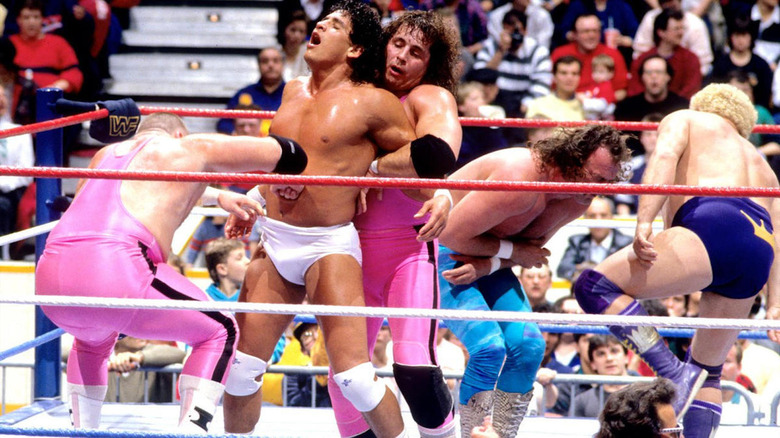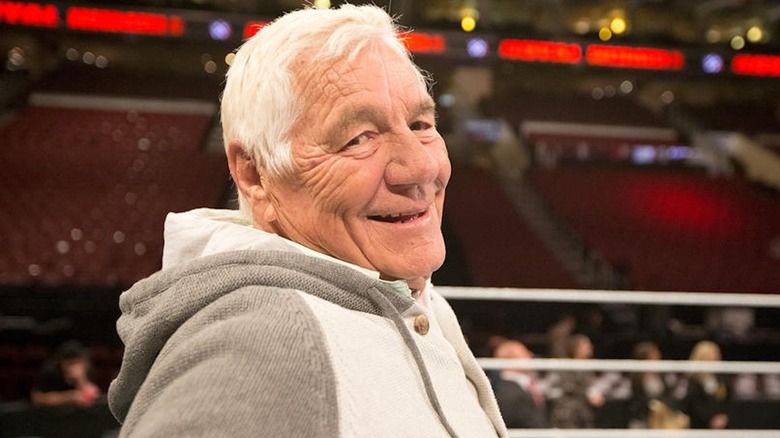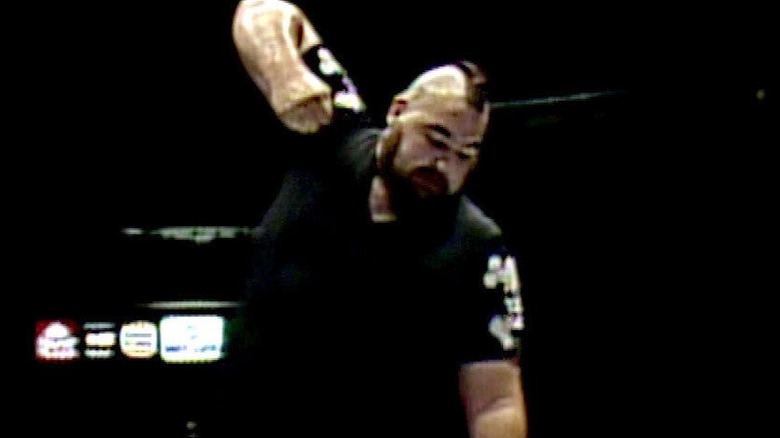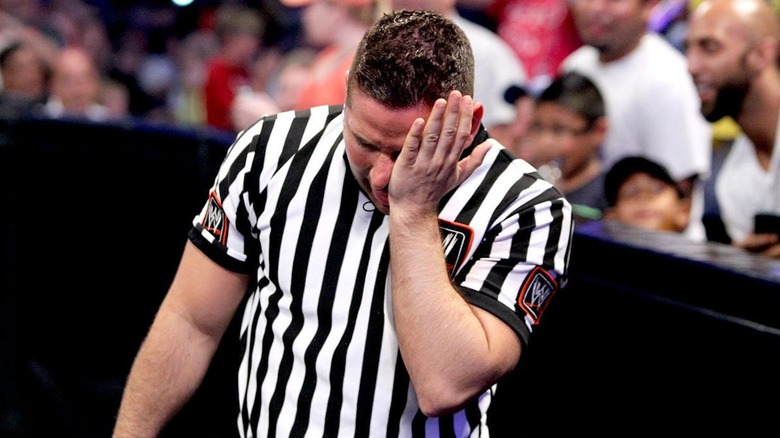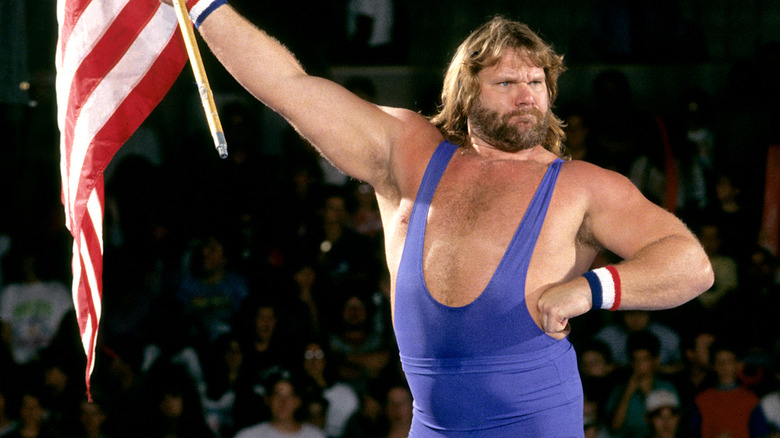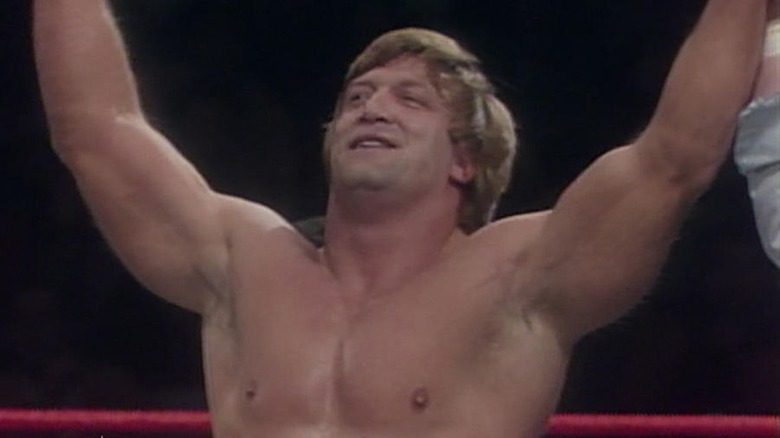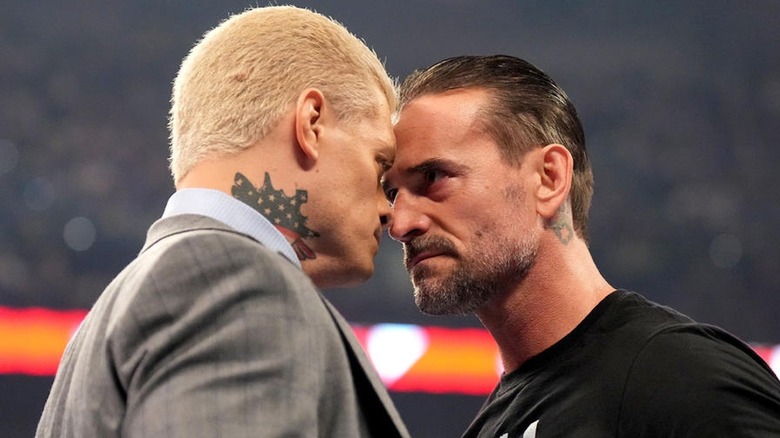The First Royal Rumble Was WWE's Greatest 'Failure'
The Royal Rumble firmly positioned itself as one of WWE's "Big Four" premium live events long ago, and in recent years, many fans and pundits would be comfortable calling it a runner-up to WrestleMania in terms of importance and popularity. As the official kickoff to WrestleMania season, the Rumble is where everything starts to heat up in WWE, a time when lapsed fans return for another run and the biggest feuds of the year, which will culminate at WrestleMania, begin to take shape.
It wasn't all that long ago, however, that the Royal Rumble was just a concept in Pat Patterson's brain, inspired by battle royals from his territory days — and something for which the legendary right hand man to Vince McMahon would have to get the boss' blessing. Ultimately, "Hacksaw" Jim Duggan would eliminate One Man Gang to cap off the first official Royal Rumble on January 24, 1988 at Copps Coliseum in Hamilton, Ontario, Canada, in front of 18,000 fans and airing as a live television special on USA Network.
But here's the kicker: That wasn't WWE's first-ever Royal Rumble, and it very nearly never saw the light of day. When the concept was first introduced, Patterson, McMahon, and WWE tested the Rumble match in front of a far smaller crowd at a non-televised event, just shy of four months prior. And it did not go well.
This is the story of the actual first Royal Rumble — a match that was initially seen as a failure, but ultimately led to a trademark event anticipated and enjoyed by millions of fans at the beginning of every year.
Patterson's vision
WWE Hall of Famer Pat Patterson's mark on the wrestling business goes far deeper than his creation of the Royal Rumble match, but alongside his inimitable status as the first-ever Intercontinental Champion, it's probably the thing for which he'll be best remembered. Patterson, who died in 2020, had long been a fan of traditional battle royals, and was known to have a penchant for helping the flow and execution of these multi-person, over-the-top-rope showcase events. In the territory days, when battle royals were promoted correctly, they could attract larger-than-life talent from all over the country — including Andre the Giant, who became known as "The King of the Battle Royal" due to his run of success in such events.
In the late 1980s, Patterson was looking to create a special battle royal concept — something that would stand apart from the traditional version where all participants started in the ring at the same time. The match, of course, would begin with its first two contestants, with all participants (at least in kayfabe) drawing a random number to determine their entrance in the match. Every two minutes, another competitor would make their way to the ring, with everyone watching not knowing who to expect next. Presumably, this would make for great drama throughout the course of what would likely be a longer match than usual — which was the reason WWF promoter Vince McMahon didn't like the idea. Patterson recounted in his 2016 autobiography that McMahon laughed at the concept, saying it would go on way too long to keep fans interested.
All these years later, fans get not one but two Rumble matches each year, thanks to the addition of the women's Rumble in 2018. But before any Rumble would ever get shown on television, let alone become the feature matches in its namesake annual PLE, it would need to be tested in a more intimate setting.
Testing the Rumble
Despite McMahon's reservations, which included calling the idea "stupid" and flat out telling Patterson it wasn't going to work, according to a 2017 interview with CBS Sports, the WWE chairman trusted Patterson implicitly and gave his concept a chance. The idea would be tried out at what was known as a house show — a non-televised live event, in this case one taking place in St. Louis, Missouri on October 4, 1987, with a reported grand total of 1,976 fans in attendance (in an arena that held 17,000).
That first Rumble would involve not what has come to be the customary number of 30 participants, nor even 20, but 12 — and despite a far smaller number of talents to manage, things did not go well. Patterson, as it turned out, wasn't present to see his vision come to life, and has stated that the other agents and officials in charge had a hard time communicating his vision. Moreover, buy-in for a foreign concept that had never really been seen before was always going to be tough. Patterson has said that the match just didn't flow well, and the crowd reaction, even as One Man Gang eliminated Junkyard Dog to win, was less than remarkable.
So with the first Rumble somewhat less than a rousing success, and McMahon as a detractor from the start, it seemed unlikely that it would be resurfacing anytime soon. But as they say, you either win or you learn, and to learn from a given failure means to assess what went wrong. For this match, there was plenty to assess.
What went wrong?
There's no doubt that the absence of the match's creator had a major impact on its trial run falling well short of success. "It didn't work," Patterson told CBS, "because I wasn't there. The producer was all mixed up and the talent was all mixed up, and they didn't know how it was gonna work."
Moreover, wrestling didn't have nearly the amount of pomp and circumstance that it does today, and at this time, many wrestlers didn't even have entrance music. These days, when you watch a Royal Rumble, half the fun is the countdown clock, which was also not highlighted in that first Rumble, and then hearing the first few beats of the new entrant's music. Absent these, and paired with a very small and likely confused crowd, you have the makings of a pretty dead atmosphere for a live event of any sort.
Additionally, and probably worst of all, the finish of the match was inadvertently spoiled by the ring announcer, who told the crowd at intermission that One Man Gang would be challenging WWF World Heavyweight Champion Hulk Hogan. The problem there was that the stipulation for the first Royal Rumble was very similar to what we've come to know today — a guaranteed title shot for the winner. So when Gang tossed Dog to end Rumble #1, the paltry audience in attendance was not at all impressed.
At this point, McMahon essentially trashed the idea moving forward until some fresh ideas were needed for an upcoming USA Network TV special in collaboration with a trusted colleague and friend.
The Rumble lives!
In preparation for head-to-head competition between WWE's network TV special and NWA's Bunkhouse Stampede in January of 1988, McMahon presented a tentative match card to NBC Executive Dick Ebersol, who had previously worked with McMahon on Saturday Night's Main Event and with whom McMahon had a positive relationship. But Ebersol wasn't thrilled about what was put in front of him, as Patterson recounted to CBS.
"For some reason, Dick Ebersol says, 'Vince, that card is really not that good,'" Patterson recalled. "'There's something missing on this show that you wrote,' and Vince turns around and says, 'Pat, why don't you tell Dick Ebersol that stupid idea you had?'"
Lo and behold, Ebersol loved the vision, telling Patterson, "My God, this is the greatest thing for television!" Aside from the official inaugural Rumble — won by "Hacksaw" Jim Duggan when he tossed out none other than the winner of the "lost" Rumble, One Man Gang — the card featured a Women's Tag Team Championship match, Ricky Steamboat vs. Rick Rude, a two-out-of-three falls tag match between The Islanders and The Young Stallions, and a contract signing between Andre the Giant and Hulk Hogan for their upcoming WrestleMania III re-match on "The Main Event," another NBC property.
But the centerpiece of the event — and the big winner — was the Rumble match, which this time featured 20 participants and some big names like Bret Hart and Tito Santana, two savvy technicians who started the match, likely a Patterson call, who could help ensure the flow would go better this time around. Jake "The Snake" Roberts, Harley Race, Hillbilly Jim, and The Ultimate Warrior were also among the participants, adding to its star power.
Recollections (or Lack Thereof) of the first Rumble
With the 1988 Royal Rumble a success — the event drew an 8.2 rating, which was the highest for any wrestling event on cable at that point — and much greater Rumble successes to come, what is remembered about that "failure" of a Rumble that only took place in front of 1,900+? The answer is ... not much.
To begin with, no one is even 100% certain which 12 wrestlers actually competed in the event. We know One Man Gang and Junkyard Dog were the final two, and we know who else was there that night — King Kong Bundy, Don Muraco, "Cowboy" Bob Orton, Ax and Smash of Demolition, "Mr. Wonderful" Paul Orndorff, Hillbilly Jim, Nikolai Volkoff, "Ravishing" Rick Rude, Davey Boy Smith, and Billy Jack Haynes — only because of their places on the rest of the card. It stands to reason, according to most, that if any of those 13 sat out the 12-man Rumble, it probably was Haynes, who had already worked twice on the undercard. But nobody can say for sure. And worse yet, several who were there don't remember much of anything about the rest of the show either.
"I wish I could give you details about it," One Man Gang told CBS in 2017, "but I really don't remember it."
"We're talking about hundreds of matches [since then]," explained Orndorff (who died in 2021), noting that he couldn't even say for sure if he took part in the Rumble.
Ax took things a step further, claiming that nobody had ever brought up the 1987 Royal Rumble to him previously. "I wish I could help you," he said, "but it would all be speculation."
Effectively, the 1987 Royal Rumble was erased from history, though its shortcomings led to the iconic annual event we have today.
The Royal Rumble today
Over the years, the Royal Rumble has evolved into a favorite WWE event for millions of viewers across the world and it serves as the launching point for WrestleMania season. It has expanded to include a field of as many as 50 (at The Greatest Royal Rumble in Saudia Arabia in 2018) but traditionally features a field of 30. Since 2018, the women's Royal Rumble match has held its place on the card, main-eventing the show in its inaugural year.
Beyond the guaranteed title shots for the winners, which became a mainstay in 1993 (won by Yokozuna), the Royal Rumble matches are often used to showcase up-and-coming talents from NXT or new to the rosters of "Raw" or "SmackDown," to debut new talents entering WWE from other organizations (like AJ Styles in 2016), to further or kickstart various storylines as WrestleMania approaches, and to harken back to years past with surprise entrances that often send the crowd into a frenzy.
Thirty-seven years after Pat Patterson's early vision was called "stupid" and flopped on its face in front of that tiny little crowd in St. Louis, the Royal Rumble is alive and thriving, ready to rumble once again every year and send the wrestling universe in fast forward toward WrestleMania.
